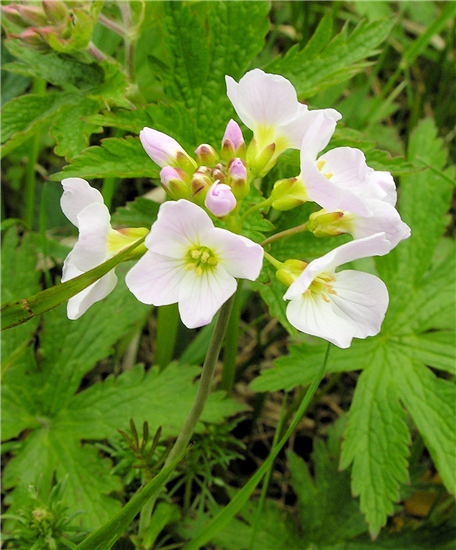A Ranger writes
Countryside Ranger Richard English shares his knowledge of cuckoos and the cuckoo flower.
May is often the month in which it feels like things are finally settling down weather-wise. It’s a chance to get away from April’s unpredictability and get set up for the approaching summer. That means there’ll probably be three feet of snow…
We should at least be able to see some of our native wildflowers starting to bloom and one of these is the cuckoo flower. It’s a delicate plant found in damp or wet habitats, such as pond margins, marshes and bogs. It was given the name because it flowers at the same time that the cuckoo starts to call. It has the characteristic four-petalled flower of the cabbage family – plants in this family are known as crucifers, as their petals make a cross shape (sort of). In the case of the cuckoo flower the petals are a pale pink, or sometimes white, which can make them stand out in amongst the surrounding greenery.
 Cuckoo flower
Cuckoo flower
Like many members of the cabbage family, the leaves form an important caterpillar food plant – particularly for orange-tip and green-veined white butterflies. The flowers provide valuable nectar for early-flying bees and butterflies. The plant is also very attractive to froghoppers – small insects that feed on sap. It is the larvae of these that produce the frothy blobs known as “cuckoo spit.”
People used to believe that if the cuckoo flower was picked and brought inside, the house would be struck by lightning. It was also thought that if eaten it would restore lost appetite and aid digestion. In the past it was also used as a substitute for watercress – another member of the crucifer family, with superficially similar leaves.
Cuckoos generally return from their wintering grounds in April but should be calling throughout May. That’s, of course, if you’re lucky enough to hear one at all. The UK population has declined significantly in recent decades, although numbers in Scotland have, happily, bucked this trend and actually increased.
 Cuckoo - credit: Walter Baxter (geograph.org.uk)
Cuckoo - credit: Walter Baxter (geograph.org.uk)
Cuckoos do not make a nest, but instead they indulge in a spot of “brood parasitism.” This involves the female finding a nest of another species and removing an egg, replacing it with one of her own. It hatches quickly and the young cuckoo pushes the remaining eggs from the nest, leaving its duped foster parents to bring it up alone. Popular victims are meadow pipits, dunnocks and reed warblers. There is evidence of these hosts rejecting cuckoo eggs, to the extent of abandoning the nest altogether. However, it appears that once the young cuckoos hatch, the parental instinct is so strong that the host will continue to feed the interloper, despite it being way too big and the wrong colour.
Adult cuckoos are similar in appearance to sparrowhawks, especially in flight. This may help them in their chosen breeding strategy. Their raptor-like appearance spooks other birds, making them abandon their nests temporarily. This allows the cuckoo the opportunity to sneak in and lay its own egg without too much fuss. Very cunning, indeed.